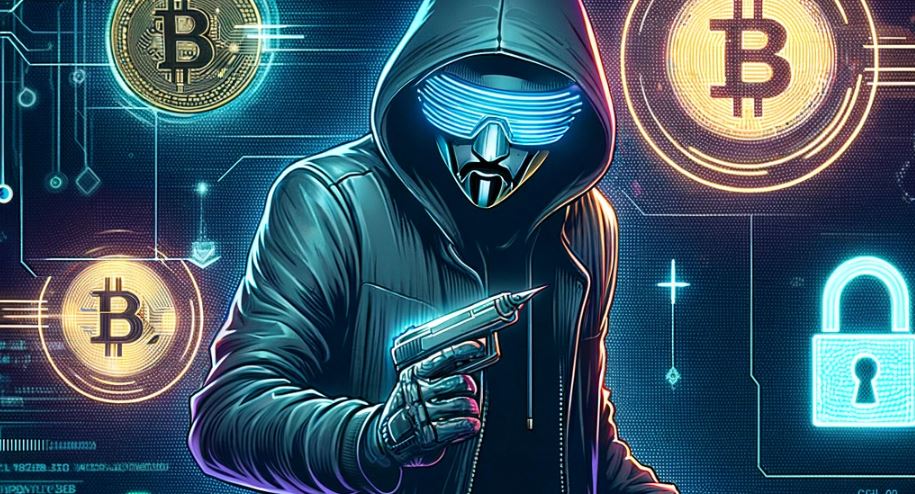In 2022, crypto criminals have stolen $12 billion, while in 2023 it was $16 billion. Sometimes it’s up to us to decide whether a move is profitable or unprofitable, but sometimes we have no control over events. In this article, we bring you what we think are the top 5 such cases.
Mt. Gox – One of The Biggest Cryptocurrency Scams in Crypto History
Mt. Gox was originally a trading platform for collectible cards known as MTGOX, which means Magic The Gathering Online Exchange. Mt. Gox transformed dramatically in the early days of cryptocurrency.
Founded by US programmer Jed McCaleb in 2010 and later sold to French developer Mark Karpelès in 2011, the Japan-based platform became the largest online crypto exchange. In 2013, it handled over 70% of all global Bitcoin transactions.

The Rug Pull: Hacks, Losses, and Mismanagement
In February 2014, the company’s website went offline, and their tweets disappeared. The case was shocking: Mt. Gox lost about 740,000 Bitcoins belonging to its customers and an additional 100,000 of its own, worth about $460 million at that time. By the end of the same month, the company declared bankruptcy.
Although the loss was announced in 2014, hacking activity had started much earlier, possibly as early as 2011. The story started in June 2011 when hackers manipulated the price of Bitcoin to 1 cent using Mt. Gox auditor’s computer to steal about 2,000 Bitcoins.
During these times, customers were left in the dark. Many even confronted Mark Karpelès directly, they wanted answers. Reports suggest that company mismanagement played a big role in the story. For example, Karpelès was the only one who could approve changes to the website’s source code, causing potential security updates to be delayed. Even before the disaster, in 2013, Coinlab had sued Mt. Gox for $75 million over a breach of contract. The U.S. Department of Homeland also investigated Mt. Gox, which led to the seizure of over $5 million from the company as it was operating without a licence.
After the hack in 2014, Mt. Gox found 200,000 Bitcoins in old-format digital wallets they had been using before June 2011. Although originally planned to be paid to the victims, the funds were held in trust as the company remained under bankruptcy protection. As the situation continued to escalate, a Japanese court ruled that the company’s assets should be returned to its creditors.
Recovery Efforts and Legal Battles
Here we need to talk about ZP Legal, a Russian law firm led by Alexander Zheleznikov. They approached Mt. Gox as they could recover up to 200,000 of the lost Bitcoins, believing they ended up in the closed exchange, BTC-e. They wanted to recover the Bitcoins from Russian nationals through legal action, suggesting a deep connection between BTC-e and the Mt. Gox theft.
In the later chapters of this ongoing narrative, CoinLab Inc., the company tasked with overseeing Mt. Gox’s North American transactions, reached a resolution agreement with Nobuaki Kobayashi, the appointed administrator supervising Mt. Gox bankruptcy, during the opening days of January 2021. As the calendar flipped to October 2021, a plan was approved to pay creditors 141,686 bitcoins, which at the time was worth over $9 billion. However, a concrete date for the payout remains unclear and shrouded in uncertainty.
On the legal front, Mark Karpelès was granted a suspended prison sentence in Japan on charges of making financial misrepresentations to potential investors. However, there is a twist in the story with the disclosure of new charges by the US Department of Justice. These charges offer a breath of fresh air for Karpelès, as the focus moved to two Russians, Alexey Bilyuchenko and Aleksandr Verner, who have been caught up in the web of suspicion for their supposed role in the laundering of 647,000 Bitcoins originally stolen from Mt. Gox.
BTC-e: Another Controversial Cryptocurrency Exchange
Bilyuchenko, Verner and their associates allegedly laundered the stolen bitcoins primarily through bitcoin addresses associated with their accounts on two other online bitcoin exchanges. Interestingly, Bilyuchenko is also suspected of operating one of these exchanges, known as BTC-e, with another individual named Alexander Vinnik.
BTC-e, which ran from 2011 until it was shut down by US law enforcement in July 2017, has a storied and controversial history. Vinnik, who had previously been charged in the US with money laundering, was extracted from Greece to France, served time in French prison for money laundering, returned to Greece after his release, and was finally returned to the US to face additional charges.
While the US Department of Justice describes Bilyuchenko and Verner as “Russian nationals”, their current location remains unknown. US Attorney Ismail J. Ramsey highlighted their criminal activities, which allowed cybercriminals, hackers, blackmailers, drug rings and corrupt officials to launder billions of dollars through their digital currency exchange.
As for Mt. Gox itself, the liquidation process is finally coming to an end. Recognised creditors of the company have until 15 June 2023 to submit verification documents. The hope now is that justice will finally find its way into this never-ending cryptocurrency saga.
OneCoin – Millions of Gullible Crypto Investors
Another high-profile story that is unique due to the cryptocurrency-based Ponzi scheme nature will be discussed in the next few paragraphs.
The Rise of OneCoin: A New Cryptocurrency Challenger – “The Bitcoin Killer”
OneCoin was founded in 2014 by Ruja Ignatova, a Bulgarian businesswoman who says she has a deep knowledge of cryptocurrencies. Notably, the company was run by two companies: OneCoin Ltd and OneLife Network Ltd. It was called as “Bitcoin killers”, OneCoin was supposed to be bigger than even Bitcoin.

Behind the Scenes: The Flawed Foundation of OneCoin
Ruja Ignatova launched OneCoin, saying it would work like any other cryptocurrency. They said that their coin could be mined with a cap of 120 billion coins and that these coins could be used to make payments. They even claimed to have an e-wallet. However, the truth came out that there was no real OneCoin blockchain model or functional payment system.
The Ponzi Scheme and Educational Facade
The company sold educational packages about financial education, such as courses on cryptocurrencies, trading, and investing. Interestingly, these courses weren’t original – much of the content was plagiarized. The whole point was that you could buy different levels of tutorials, and these levels determined how many tokens you get to able to mine the coins. Moreover, it was based on one of the most common scam, the MLM system, as the rewards also depended on how many new users you could bring in.
xcoinx: The Crypto Exchange Exclusivly for Onecoin
OneCoin had an exclusive crypto trading platform named xcoinx. This exchange was the only platform where OneCoins could be converted into other currencies. However, there was a catch – only members who purchased more than the beginner package had access. Selling limits depended on the level of the educational package bought. By January 2017, xcoinx was closed and the company consistently denied withdrawal requests from affiliates.
Red Flags and Global Investigations Against the One of the Biggest Crypto Scams
Many aspects of OneCoin raised doubts:
Non-Transparent Operations: The company was known for its secretive operations.
Centralization: Unlike other cryptocurrencies, it was entirely centralized.
No Public Ledger: There was no verifiable blockchain technology behind.
Educational Packages: One had to buy ‘educational’ packages to receive OneCoin tokens.
Lack of Usability: The coin couldn’t be used for real-world purchases, nor was it traded on any authentic exchange.
In 2016, the company was investigated in several countries, such as Norway, where the Direct Selling Association declared the company to be a pyramid scheme, and later in Hungary, where the Hungarian Central Bank issued a warning on the same grounds.
The Downfall and the Elusive Fraudulent “Cryptoqueen”
In 2018, the Bulgarian police raided the company’s offices. Though Ruja Ignatova disappeared in 2017, her brother, Konstantin Ignatov, took over the company’s operations. By 2019, both Greenwood, the co-founder, and Konstantin were arrested. Konstantin admitted guilt to multiple charges, while Greenwood began discussions on a possible plea deal.
Ruja Ignatova, often called as the “Cryptoqueen” has remained missing since 2017. Her whereabouts remain one of the crypto industry’s biggest mysteries. Even if she did not become the world’s crypto queen in a good way, Ignatova set the bar high, as she is still the only woman “boasting” a top 10 FBI wanted list.
FTX – The Biggest Crypto Scam of all Time?
In this chapter we explore the FTX fraud case that has shocked the crypto market. We cover the history of the company, from its rise to its fall, and the current events surrounding it.
Origins and Evolution of FTX
In 2019, Sam Bankman-Fried (SBF) and Zixiao “Gary” Wang founded FTX (“Futures Exchange”), which was originally part of Alameda Research, also founded by SBF. Alameda was a trading company co-founded with Caroline Ellison back in 2017.

Bankman had previously worked on Wall Street, so was no stranger to the world of finance. The founders’ goal was to create a platform focused on trading cryptocurrency alternatives and leveraged products, which also allow crypto assets to be stored in the company’s crypto wallets (these are hot wallets, so you don’t own the private key).
The company’s rapid rise was helped by the event in 2019 when Changpeng Zhao (the CEO of one of the largest crypto exchanges, Binance) bought a 20% stake in the company for around $100 million. But beyond that, the platform was also basically well developed, offering a super-comfortable user interface and various innovative products and services. It was among the first to offer tokenised stock and options trading. The company was valued at $32 billion in January 2022.
As FTX grew, it became the second most valuable crypto exchange platform in 2021, behind Binance.
FTX’s token and the Alameda Connection – Scammed Investments
FTX launched its own digital token, FTT, in May 2019, which aimed to attract new customers to invest in crypto by offering various benefits to those who held their investments in the token. Using the tokens, users could also earn NFTs as rewards and discounts. The tokens are also important because they were used as part of Alameda’s assets. Which is probably what caused the crash.
In November 2022, Ian Allison published an article on CoinDesk about the connection between Alameda and FTX. The article revealed that Alameda was heavily dependent on FTX tokens, with $5.8 billion of its $14.6 billion in assets in FTT tokens. Some time later, FTX’s balance sheet was also leaked, showing that it had only $900 million in assets against $9 billion in debts, resulting in a negative balance of $8 billion.
According to the Wall Street Journal and the New York Times, FTX has loaned Alameda large amounts of money, some $10 billion of its clients’ invested capital. In this financial sector, a private company is not required to audit its financial statements, allowing this massive financial problem to be hidden.
The Downfall of FTX
Sam Bankman-Fried contacted a number of vendors to solve the liquidity problems, including the likes of Coinbase and OKX. In the end, Binance seemed to come to the rescue. Binance had signed a non-binding agreement to buy FTX’s units outside the US, but further obligations came up during the process and it finally backed out.
On 8 November, FTX blocked user payments, leaving many customers without access to their money. FTX finally filed for bankruptcy protection in the US and Bankman-Fried left as CEO.
On 12 December 2022, SBF was arrested in the Bahamas and charged with fraud and conspiracy. He pleaded not guilty to the charges in the first round and denied stealing any money. Instead, he has blamed FTX’s bankruptcy on the crypto price crash.
Is this the world’s biggest crypto scam? We’ll see, as this is not the end of the case and it continues to grow. The latest details include the testimony of SBF trustee Caroline Ellison, who accuses Bankman of ordering her to fake the balance sheet. At the time of writing, Bankman has pleaded not guilty to all charges, neither to the 2 frauds nor to the 5 conspiracies. However, he admits that while he made mistakes in running FTX, he never meant to steal money.
Update (3th of November, 2023) – SBF Was Found Guilty!
Sam Bankman-Fried was found guilty of all charges against him. The trial took place on 3 November 2023. But it’s not over yet! You can find more in our magazine about this case.
Bitconnect
Bitconnect entered the cryptocurrency scene in 2016 and quickly gained popularity. It promised high investment returns through a trading bot that would exploit bitcoin’s volatility. By early 2018, however, it became clear that Bitconnect was not what it seemed.
What Was Bitconnect?
Bitconnect was a cryptocurrency platform offering various services, including lending. New investors were invited to exchange their Bitcoins for Bitconnect tokens. They were promised a return on investment (ROI) that could reach up to 40% per month. They said that this remarkable ROI was generated by their bot that exploited Bitcoin’s volatility.
The Red Flags
Several warning signs indicated Bitconnect’s failure:
- Guaranteed High Returns: Any investment promising consistent, high ROIs should always be approached with caution. Given the volatile nature of cryptocurrencies, the returns promised by Bitconnect were not only high but also consistent.
- Obscure Business Model: Bitconnect never provided transparent insight into how their trading bot operated, nor did they offer any proof of its existence.
- Promotion through Referrals: Bitconnect heavily motivated users to recruit others, offering bonuses for each new recruit. This pyramid structure is a classic feature of Ponzi schemes.
- Skeptical Community: Many high-profile figures within the cryptocurrency community voiced their concerns and skepticism regarding Bitconnect’s operations and promises.
The Fall of Bitconnect
By late 2017, regulatory bodies began taking notice. Authorities from multiple countries issued warnings or took direct action against Bitconnect:
- The UK Registrar of Companies threatened to shut down Bitconnect if it failed to prove its legitimacy.
- The Texas State Securities Board issued a cease and desist order against Bitconnect.
- North Carolina’s regulators followed suit with similar actions.
In the face of growing pressure, Bitconnect suddenly shut down its lending and exchange platform in January 2018. They listed reasons such as bad press, cease and desist letters and continued DDoS attacks. For many, however, these reasons were simply an excuse to exit, leaving thousands of investors hanging.
Aftermath and Lessons Learned
The consequences of the Bitconnect scam were catastrophic for many investors. Many lost their life savings and trust in the crypto community was damaged. According to the SEC, the loss is around $2 billion. The search for justice continues, although American Glenn Arcaro, the company’s promoter, and Indian Satish Kumbhani, Bitconnect’s founder, have already been charged with money laundering and other crimes.
Filecoin
Chinese authorities have taken significant action started on August 14 in 2023 against an alleged Filecoin cryptocurrency mining pyramid scheme that ensnared investors out of over $83 million. This case has been one of the significant developments in the ongoing efforts of the Xi Jinping government to regulate and crack down on crypto-related ventures in China.
The Genesis of the Scheme
The company in question, Shenzhen Shikongyun Technology, was initiated in 2018 by founders Lai Mouhang and Lai Moujun. As per records, two additional executives joined the duo later that year. This conglomerate expanded its operations in 2019, recruiting thousands of crypto investors primarily through their website ipfs.cn. They promoted their venture as an investment in distributed ledger technology, highlighting the Filecoin ecosystem.
In an effort to attract more investors, they launched two platforms, filpool.io and bpool.io, which they advertised as Filecoin mining pools. Potential investors were recruited into the scheme with the promise that they could participate in the block reward mining process and earn FIL tokens in return for leasing mining equipment from Shikongyun Technology.
The scheme was structured in such a way that those who invested larger amounts were rewarded more, adopting a tiered investment approach. One of the features of this system was that higher level members, such as Bronze Members, could recruit others and receive a share of their recruit’s earnings. This type of structure is a common feature of pyramid schemes.
The Magnitude of the Scam
The public prosecution pointed out that the defendants used unrealistic profit projections as bait, promising significant returns, which played a key role in their fraud. The number of investors the scheme attracted was over 57,000 individuals investing an amazing RMB 607 million (US$83 million) in cash and RMB 62 million (US$8.5 million) in digital assets.
Despite the Chinese government’s tireless attempts to clear the country of crypto miners, this scam has continued to flourish. Surprisingly, even in the middle of such a crackdown, only the United States was found to have a higher BTC hash rate than China.
Legal Ramifications and Broader Impacts
The case against the executives of Shenzhen Space-Time Cloud Technology could potentially set the pace for how China handles and regulates crypto scams in the future. The ongoing public hearing is a clear indication of China’s firm stance against fraudulent crypto practices and could set an important precedent.
How to Avoid Crypto Scams?
To avoid cryptocurrency scams, exercise caution and do your research before making any investment decisions. Always be skeptical of offers that seem too good to be true or promise high returns with little risk. Use secure and reputable cryptocurrency exchanges, and avoid sharing personal information or sending money based on unexpected requests or unfamiliar sources.
Phishing, Fake ICO’s, Romance Scams, Ponzi Schemes – DYOR Before You Investing in Crypto
Be aware of common scam tactics such as phishing emails, fake ICOs (Initial Coin Offerings) and Ponzi schemes or romantic scams. Also, keep your cryptocurrency in secure wallets, ideally offline or hardware wallets, to protect it from theft. Always remember, when in doubt, ask for expert advice or further validation before taking any action.




